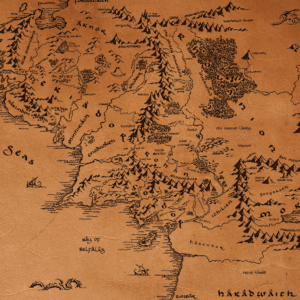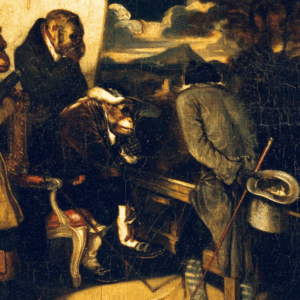
Include as Little History as You Can: The Danger of Explaining Too Much in Historical Fiction
Jesse Browner Explores Why the Core Rules of Fiction Still Apply in Stories of the Past
In 1964, when Supreme Court Justice Potter Stewart was asked for his definition of obscenity, he famously replied, “I know it when I see it.” Like a cohort of sinners in a lower circle of hell, we are so deeply immersed in a feculent sea of pornography these days that the issue has become redundant, but you can still ask the same question about historical fiction. Do you know it when you see it?
Sure, you say; Sir Walter Scott, Margaret Mitchell, James Fenimore Cooper, Jean Auel and Henryk Sienkiewicz all wrote what anyone would recognize as historical novels. But what about Balzac, Stendhal, Tolstoy, Faulkner, Toni Morrison and Gabriel García Márquez, all of whom wrote novels set in the historical past? Are they historical novelists too?
Don’t even think of asking the so-called experts to define what historical fiction is. They keep trying, and they keep failing. At a seminar entitled “What is Historical Fiction?” held at Oregon State University in 2003, opinions were all over the place.
Walter Scott was cited as claiming that the “novel should be set at least two generations past,” whereas the scholar Ernest Leisy believed the cut-off was a mere half a generation. The Historical Novel Society insists that a historical novel must be written at least fifty years after the events depicted, but Lynda Adamson, author of American Historical Fiction, shaves that down to twenty-five.
Professor R. Gordon Kelly is quoted as writing that “[a] historical novel is a novel the action of which is laid in an earlier time,” to which Joyce Sarricks of the Downers Grove, Illinois, Public Library responds that “the simplest definition of historical fiction is that it is set in the past, before the author’s lifetime and experience.”
Don’t even think of asking the so-called experts to define what historical fiction is.
Assuming on this basis that there’s no such thing as a wrong answer, we can lump every landmark of world literature from The Iliad (written several centuries after the event), Beowulf (four hundred to five hundred years) and Luo Guanzhong’s Romance of the Three Kingdoms (eleven hundred years) to A Tale of Two Cities (eighty years) and Ulysses (fifteen years) into the category of historical fiction. And why not? Who cares?
As it happens, the authors who want to be known as historical novelists care, as do the writers who do not care to be known as historical novelists.
In an article published in The Guardian in 2017, Hillary Mantel recalled that back in the 1970s, “historical fiction wasn’t respectable or respected. It meant historical romance.” If you read a great novel that happened to be set in the historical past, like Robert Graves’ I, Claudius, “you didn’t taint it with the genre label, you just thought of it as literature.”
We have all been informed that so-called historical fiction is enjoying something of a golden age right now and that, for the most part, such narrow and narrow-minded definitions no longer hold true, thanks in great measure to writers like Mantel, Pat Barker, Colson Whitehead, Emma Donoghue and even George Saunders.
And yet the genre persists and thrives as a safe space for novelists as varied as Robert Harris, Patrick O’Brian, Álvaro Enrigue or Philippa Gregory, none of whom could plausibly object to being branded as historical novelists. Amazon lists at least a dozen primers on how to write historical fiction.
Golden age or no, there remains a clear divide between authors of literary fiction in historical settings (in which, Mantel writes, “history…is the method we have evolved of organizing our ignorance of the past”) and authors of historical genre novels (in which, according to one pundit, the author’s paramount task is “[g]etting things to look right.“) And that doesn’t even begin to touch on the danger, duly noted by Wikipedia, of confusing historical fiction with alternate history, counterfactual history, non-fiction novels or pseudohistory.
I have a novel coming out this spring that, I imagine, most readers would categorize as historical fiction, even as I myself remain leery of the label. Prior to this, I wrote one other historical novel, set in first-century Rome, not because I had any interest in writing historical fiction but because the story I wanted to tell was based on a supposedly true event that happened to have occurred at that time.
With the new book, too, set on the periphery of the ancient Hittite empire, my interest was focused not on the historical elements of the story but on the opportunities it offered my young hero to perceive and imagine the world outside the blinders of modern sensibilities. If I could have written these two books without the artifice of their historical settings I most certainly would have, because every item of extraneous detail serves as one more obstacle between the mind of the reader and that of the character.
And also, you have to believe that there’s a difference between history and fiction. If, like me, you suspect that all history is fiction; that all attempts to recreate history results in fiction; and that aside from dates, casualty lists, logs, ledgers and other sources of quantifiable data, there is no such thing as historical fact, you should properly avoid calling your work historical fiction.
In an essay titled “The Tourist, the Expat, and the Native,” novelist Mary Volmer writes that, “The more skillfully we craft the context of a story, the more convincing the illusion of authenticity. This is a large part of our goal when writing historical fiction: to create the illusion of authenticity.” With all due respect, I could not disagree more thoroughly. A novel can never be an illusion of anything. It must be wholly and inherently a thing entire unto itself.
When writing historical fiction, the last thing we seek is the illusion of authenticity, which is what we get when we substitute historical facts for human uncertainty. Most of us are no closer to understanding the reality of the time and place we live in than some moment in the distant past that we have read about in a few books.
It is precisely this uncertainty that makes historical fiction authentic. It should not take Hillary Mantel to remind us that, “you become a novelist so you can tell the truth.” Just as there is a difference between fact and truth, there is a difference between history and the past, and, as Mantel points out, they must be retrieved differently.
You could read a thousand books about the Assyrians and still have not the foggiest idea what an Assyrian thought upon waking up every morning or what she felt about her family, her culture, her work or her soul. The truth is, no matter how much you may think you know about them you know nothing, or so little that it’s worse than nothing. Until you acknowledge that truth to yourself and, indirectly, to your reader, the fallacy of authenticity will present itself again and again as an irritant and a stumbling block to you both.
When Seamus Heaney translated Beowulf, he didn’t speak a word of Old English, and yet he was able to milk as much meaning from the poem as it is possible to milk without having lived in Scandinavia in the sixth century or spoken Old English as a native. Even so, Heaney had to make choices about which meanings were more relevant than others and which needed to be abandoned as beyond his reach and ours.
For instance, the caesura that is commonly found at the center of each line of Anglo-Saxon verse conveyed a meaning to native speakers that is lost to us today. You can claim that it’s there to give the bard a chance to catch his breath, and that may be correct as far as it goes, but you cannot possibly understand how the rhythm it created mimicked the speech of its intended audience or reminded them of their home, their childhood, their history or their loved ones.
The same holds true for the poem’s internal rhymes and alliterations, which held a non-verbal meaning for the listener that no twenty-first-century reader can pretend to know. So if they mean nothing to the modern reader, why include them? Because they make the translation sound more like the original?
Yet if these sounds transmit no intelligible meaning they become extraneous, a barrier to understanding rather than a conveyor of it. The same is true of any historical detail that the reader is compelled to circumnavigate to reach the truth.
Closer to home, all the great French playwrights of the seventeenth century wrote in alexandrines, which are relatively rare in English-language poetry and can sound an oddly foreign note. (Take, for instance, Thomas Hardy’s poem “The Convergence of the Twain” about the wreckage of the Titanic: “Steel chambers, late the pyres/ Of her salamandrine fires, / Cold currents thrid, and turn to rhythmic tidal lyres.”)
Yet you only need to hear a few lines of iambic pentameter and you are immediately on native ground, roast beef and ale, even if you haven’t understood a single word. On a conscious level you may not fully grasp why you are moved by this particular meter, but it is nonetheless a powerful transmitter of acquired meaning.
Writing historical fiction poses a similar dilemma. The Romans doused all sorts of dishes with garum, a condiment made of salted, fermented fish guts. So critical was garum to Roman cuisine that the empire’s entire Spanish and North African coastline was studded with sprawling garum factories.
To a Roman, especially one who found herself far from home, the taste of garum must have been an instant conjurer of memories happy and sad, childhood, grandparents, places, events, conversations, journeys, feuds and reconciliations that made a Roman uniquely Roman. But if I include it, say, in a banquet scene set at a stately Roman villa, how do I convey what it means to the diner without derailing my narrative?
If I tell you that it tasted like nuoc mam (which it probably did), that would be a gross anachronism. If I describe what it’s made of and how it’s manufactured, my Western readers are most likely to be amused or appalled, which would obviously undermine the essential significance of the detail to my characters, because then the story becomes about the garum when the garum should be about the story. It must instead, as Francis Spufford wrote about his historical novel Golden Hill, be “narrative not in the service of some other thing.”
On the other hand, if I dive deep into all the layers of meaning which the taste of garum conveys to my characters, I run the risk of interrupting the flow of my story with superfluous detail or of artificially manipulating my characters into entertaining thoughts and emotions that their situation does not call for.
Worse yet, if I describe garum as a kind of ancient madeleine, or apple pie, or ballpark frank, or whatever food the reader associates with home, family, and safety, I force my characters into thinking and behaving like twenty-first-century actors in togas, and then what’s the point of writing a historical novel in the first place?
You don’t want to end up explaining how to string a bow or lace a kirtle when you should be developing your character, or you’ll end up in Exposition 101 before you know it. As Spufford explains,
before the writing of a description or a piece of action, there’s the whole question to be thought through, of how the person in whose viewpoint you are understands it, and therefore what will be prominent in it for them; what they will notice, ignore, love, hate, take for granted; and then what, beyond that, but without spoiling the integrity of an owned vision, the reader may also need to be shown, on the quiet.
Imagine writing about a summer picnic in the Midwest at which apple pie is served for dessert. The characters are not thinking about the apple pie as they eat it; with any luck, they are thinking and talking about the things that real people think about when they are in each other’s company.
But now, imagine that you had to pause the narrative to explain the history of apple-pie making in the United States, the centrality of apple pie to American culture and mythology, what an apple pie tastes like and all the instances in which the consumption of apple pie contributed to the layering of a character’s memory, identity and sense of home.
Maybe you would write it down just to help you understand your own protagonist’s inner life, but, hopefully, you would think twice about including it in your final draft. That’s how you have to think about what details to include in your historical novel.
*
Having failed to nail down a definition of historical fiction, is there, likewise, anything of further significance or utility we can say about how much history is too much history? Maybe not, but simply asking the question may help you understand something important about yourself as a thinker and a writer. It’s probably fair to say that anyone who commits to writing a full-length book set in a past beyond living memory must enjoy doing research.
James Joyce famously researched the weather reports for Dublin on June 16, 1904, so that a cloud seen crossing the sky in one scene of Ulysses had moved the appropriate distance and in the right direction in another, based on the prevailing wind speed. Nobody goes to such lengths unless they really, truly love that sort of legwork.
But Joyce never told anybody (at least, not his readers) what he had done, and you would have no way of knowing that he’d done it just from reading the novel. In fact, you are arguably worse off knowing it because now you’ll be looking for it the next time you read Ulysses, instead of putting your mindfulness to more rewarding use.
I tell my writing students that every book and every poem should be as brief as it can be. I hope it’s obvious that this doesn’t mean they need to be short; they simply need to include no extraneous prose of any kind—every word more than is needed is redundant. Proust’s À la recherche du temps perdu is a perfect example of a very long piece of prose that is as brief as it can be and in which every single word serves an explicit purpose.
The same can be said of every novel ever written by Dickens or Tolstoy or George Eliot. In that logic, I have come to the conclusion that the best way to write historical fiction is to include as little history as I possibly can.
In that logic, I have come to the conclusion that the best way to write historical fiction is to include as little history as I possibly can.
So where does this leave you if you’ve spent months, maybe years, researching Tudor England for your novel about Anne Boleyn’s Havanese, Purkoy? You are understandably reluctant to let any of it go to waste. Yet you can’t possibly include it all or even most of it, any more than you could row across a lake with a steamship’s anchor at your bow; it would sink you.
Whatever fails to fill your sails with wind will merely weigh down your vessel with unnecessary ballast. You will have to jettison most of it to get where you want to go. The research you have done will not go to waste, because it will color your imagination in ways you may not even be aware of, but if you do not have the self-discipline to unpack your steamer trunk and take only enough gear on your journey to fill an overnight bag, you may want to consider visiting somewhere closer to home.
In the long run, it might be helpful when thinking about historical fiction to remind yourself that history is fiction, that fiction is history in utero, and that the twain shall meet often and intimately. The rules are reciprocal and mutually reinforcing: Tell your story and be aware at all times of what it needs and, just as critically, what it does not need to get it from A to B.
If you are Patrick O’Brian, that may be twenty pages on how to rig the masts of a nineteenth-century frigate; if you are James Joyce, it may mean mastering the aerodynamic qualities of a fluffy Irish cumulus. Since there’s nobody out there who can offer a reliable definition of historical fiction in any case, only one thing will matter in the end. It has to float.
______________________________

Sing to Me by Jesse Browner is available via Little, Brown.
[iii] Thomas Mallon (“Writing Historical Fiction” Thomas Mallon, https://www.jstor.org/stable/41213401)
Jesse Browner
Jesse Browner is the author of the novels The Uncertain Hour, Everything Happens Today, and Sing to Me, among others, as well as of the memoir How Did I Get Here? He is also the translator of works by Jean Cocteau, Paul Eluard, Rainer Maria Rilke, Matthieu Ricard and other French literary masters. He lives in New York City.












